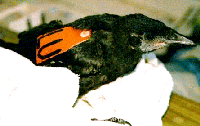
So, what's with those crows with colored wings anyway?
Or Reporting sightings of tagged/banded crows.

All photographs (c) Kevin J. McGowan and not to be used without express written permission.
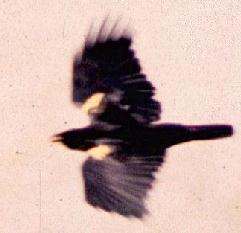
What are those crows doing with tags on their wings?
Don't the tags and bands hurt the birds?
What do the different colors and letters on the tags and bands mean?
If I see a tagged crow, do you want to know about it?
What kind of information do you want?
I saw a crow with white in its wings. Is that one of yours?
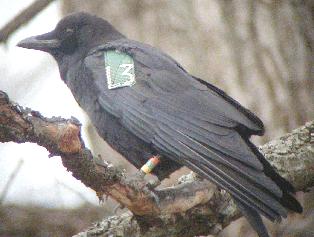 What are those crows doing with tags on their
wings?
What are those crows doing with tags on their
wings?
I have been studying crows (both American and Fish) in the Ithaca area since the summer of 1988, and marking birds since 1989 (color bands only in '89). I am trying to gather data on social behavior, reproductive biology, dispersal, and survival (especially after exposure to West Nile virus) on both these poorly-studied species (see my project overview). In order to gather such data I needed to have some way to know individual crows as individuals, hence the tags and bands. Because crows spend so much time walking around on the ground where even short grass hides their legs, the wing tags have been invaluable for finding and identifying individual crows. On a good day I can identify an individual crow up to a half mile away. (A good day being one with the right atmospheric conditions, little fog or heat distortion; some tagged crows visible across an open space, say a field of corn stubble; and me having my trusty Swarovski ATS 80 spotting scope with me, with its superb 20-60x zoom lens and incredible optics.)
Don't the tags and bands hurt the birds?
No. They are designed to be as innocuous as possible. Birds' "hands" are connected to their shoulders by a flap of skin (called a propatagium or simply patagium) that makes up the front edge of the wing. The flap is relatively thin, contains no muscle and only a few blood vessels. The tags are attached by a small piece of nylon sticking through the patagium. The ends of the nylon pin are melted to hold the tag on (with washers in place to decrease abrasion on both sides of the wing), and the tag sits on top of the wing. The tag does not interfere with any movement and does not pinch or rub any skin. Crows often preen the tags into place just like a feather. When I pierce the patagium to attach a tag the crow usually does not even flinch. They get more agitated when I measure their tail than when I stick in the pins.
Such obvious markers seem like they must increase the likelihood that predators will attack the crows or that other crows will shun them, don't they? To the best of my ability to detect it though, neither thing appears to be true. Unfortunately I cannot make direct comparisons on the survival of tagged and untagged crows because survival cannot be determined without marked individuals! I can say, however, that survival of tagged crows is extremely high. Fully half of all young crows that I mark in the nest are alive one year later. That may seem like a low survival rate, but in fact it is one of the highest known for birds! Breeder survival is on the order of 93% per year, again an incredibly high survival rate for birds. (See McGowan 2001 for published survival rates.)
Crows with tags do not appear to be at any disadvantage in relations with other crows either. Again, it is impossible to have comparison data on unmarked crows, but tagged crows are accepted perfectly fine into their family units. They do not seem to be more involved than unmarked crows in fights and chases in big flocks (either as the pursuer or pursuee). And, they DO successfully compete for breeding spots. I have had over 75 tagged individuals successfully become breeders in my study.
No scientist manipulates their study subjects in any way without a great deal of thought and concern. Every researcher at a public institution in this country must have their proposed protocol approved by their Institutional Animal Care and Use Committee (my approved protocol number at Cornell is 88-210-04). But quite apart from the regulations and laws, good science requires that animals under study are interfered with as little as possible. And that is on top of the personal ethical decisions that each researcher must make about their comfort level with any action taken (or not). In my study I am interested in keeping the crows alive and visible, and if I knew that anything I was doing adversely affected the birds I would stop. I am fortunate to be able to state that the colleague who taught me the marking technique I use is very active in the Humane Society and People for the Ethical Treatment of Animals. Although I made my own evaluations, it seemed to me that her standards were likely to have been even more stringent than my own. I reasoned that if she was happy with the technique, then I probably would be too. And I have been.
What do the different colors and letters on the tags and bands mean?
The colors of the tags represent different years, as does the specific arrangement of the colored leg bands relative to the metal band. The combination of letters indicates the specific individual (its NAME), as does the specific sequence of leg bands.
All crows marked in the study (except those banded in 1989) received two wing tags, colored leg bands, and a USFWS aluminum band. Each individual crow banded before 1998 got tags with a unique two-LETTER (no numbers) combination (same on both wings) and a unique sequence of colored leg bands. Starting in 1998 I began to use a combination of LETTERS AND NUMBERS on the wing tags (I had used up all possible two-letter combinations). Note that "zero" is used, and to distinguish it from "O" the letter, the zero has a small slash inside. The first character was a letter and the second a number from 1998 into 2001. Starting in 2001 the number came first and the letter second. I used up all available number-letter combinations in 2003 and had to start on two NUMBERS. (I'm not sure what I'll do when I use those up.) I did not number them consecutively, but rather chose to spread out the numbers within a family.
Until 1998 when I started repeating tag colors, each
year class had received a different color of wing tag. I now have used all my available
tag colors and am repeating them. So far I have an 8 year gap between colors, and I rarely
have had a tag last 8 years. Each year cohort still gets a different arrangement of the
colored bands relative to the metal band. I alternate dark tags with white letters and
light-colored tags with dark letters each year. The dark tags all tend to look similar,
appearing white at a distance. Differences between year classes can be seen in the amount
of wear of the tag more readily than in the color. Recent tags (one or two years old) are
bright in color and look neat and sharp on the edges. At about 3 years of age the tags
start to get a little frayed at the edges. By four years many tags are severely frayed and
many have fallen off (although I have taken steps in the last 3 years to minimize this
problem). The tags were made of herculite, which is a light plastic covering a nylon mesh.
In 2003 I changed to Cooley, a similar material. As the tags age they crease,
cracking the plastic and allowing the white nylon to show. Sometimes this wear can result
in white lines of dark tags that have no relation to the painted letters. Reading old tags
is something of an acquired skill. Note that all crows originally received a tag on each
wing and four leg bands (at least one on each leg), but some are missing one or more of
each.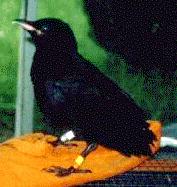
The leg bands are read from the top of the leg to the bottom, the bird's right leg first, a dash to indicate the change of legs, then the left leg. The color designations are W = white, B = "blue" or dark blue, Y = yellow, L = "lime" or light green, O = orange, P = purple (sort of a lavender), R = red, A = "azure" or light blue, F = "flesh" or light pink, G = "green" or dark green (not used anymore), S = "silver" or the metal band. So the little guy in the photo on the right is WS-YO. As the bands age, unfortunately they change color somewhat. W, Y, and F converge on a dirty white. A used to become rather white as well, but now it turns light green. The other colors stay fairly true, but R can fade to resemble O. Some old birds have lost a few colored bands, and the oldest (up to13 years old at the time of writing this) have lost most of them.
The specific age classes of tags and bands are as follows (in the leg band key, S is the metal band, C represents a colored band, and the dash "-" is as explained above):
| 2004 Crows | Light green tags with white letters | 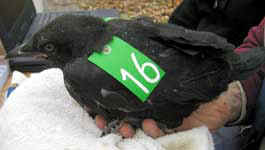 |
Leg bands SC-CC | We finished up the last two-number combinations this year, so had to start repeating two-letter combinations from the beginning of the study. We attempted to avoid combinations of well known birds from the first years. |
| 2003 Crows | Orange tags with black letters | 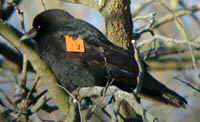 |
Leg bands SCC-C | We finished up the last number-letter
combinations this year, so had to start on two numbers.. We tried a new technique this year, using press-on letters instead of paint. Although they're very legible, they are starting to peel off! So, watch for incomplete characters. |
| 2002 Crows | Olive green tags with white letters | 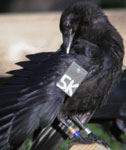 |
Leg bands CCC-S | |
| 2001 Crows | Yellow tags with black letters |  |
Leg bands CC-SC | |
| Unknown aged crows, marked as adults in 2001 and later | Navy blue tags with white letters; now using royal blue with white letters | 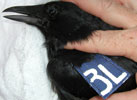 
|
Leg bands CS-CC | |
| 2000 Crows | Gray tags with white letters | 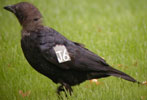 |
Leg bands CCS-C | |
| 1999 Crows | Light blue tags with dark letters | 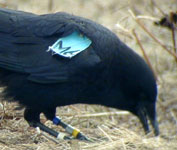 |
Leg bands C-CSC | These tags have an unfortunate tendency to curl upwards so that the letters become unreadable. |
| 1998 Crows | Dark green tags with white letters | 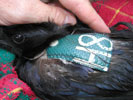 |
Leg bands S-CCC | |
| 1997 Crows | White tags with black letters | 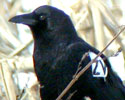 |
Leg bands C-SCC | |
| 1996 Crows | Black tags with white letters | 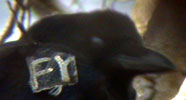 |
Leg bands CSC-C | |
| 1995 Crows | Red tags with black letters | 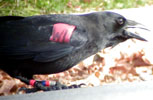 |
Leg bands C-CCS | From here back, most of these tags are gone. |
| 1994 Crows | Dark greenish gray tags with white letters | 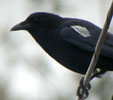 |
Leg bands CC-CS | Most are very tattered, if present.. |
| 1993 Crows | Yellow with black letters | 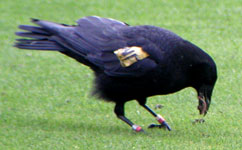 |
Leg bands SC-CC. | Only a couple of birds still with tags, but they're very ratty. |
| 1992 Crows | Olive green tags with white letters | 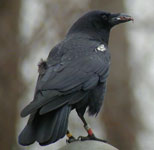 |
Leg bands SCC-C | All of these tags are gone now too. Only stubs are left. They are starting to lose the colored leg bands too. |
| 1991 Crows | Light blue tags with black letters | None of these tags should still be in existence | Leg bands CCC-S | Most of these birds are missing some of their colored leg bands. |
| 1990 Crows | Dark green tags with white letters | These tags are gone now. Sometimes you can get a gimpse of the tag when they are flying, but mostly it's the leg bands that identify them. I only know of two of these individuals alive at the moment: one the Dewitt Middle School, and his brother just to the south on Christopher Circle. | Leg bands CC-SC | The colored leg bands on these birds are nearly all gone. |
| 1989 Crows | none | The bands I used were homemade, and are all probably gone. I do not know of the existence of any of these individuals at the moment If you see a crow with only a metal band on its right foot, it might be one of these. But you'll have to read the numbers off the band to be sure. Now there's a challenge! But, I assure you, it can be done. | Colored leg bands only (CS-CC) |
If I see a tagged crow, do you want to know about it?
Yes! Reporting sightings is useful to me for several reasons. If a tagged bird is reported I know that one of my birds is in that location (which I may or may not know about). If the tag is read and the bird identified (as explained above), then I know that that individual was alive at that time and where it was. I routinely look for tagged individuals and try to keep track of who is where. I have marked about 750 crows over the study, however, and I cannot find them all. Crows can travel large distances (at least to Pennsylvania, West Virginia, or Boston from Ithaca), and there are a lot of other crows out there, so reports from other people have been very valuable. I may or may not have recently seen the crow you report, but I will always be interested in hearing about it. Through reports by others I have found out that some young Ithaca crows spend the winter in Pennsylvania (even though siblings from the same nest of one stayed with the parents on territory all through the winter, and the PA wanderer came back to help its parents during breeding season), and that some have dispersed as far as Geneva, NY to breed. Volunteer sightings have allowed me to calculate (minimum) survival data, data previously unknown for these two species, perhaps the least studied of all North American game birds.
What kind of information do you want?
The most important bits of information I am interested in are WHO you saw (letter combination, color of tag, leg band colors and sequence), WHERE you saw it, and WHEN you saw it (date and time). I also would like to know how many other crows it was with, how many were tagged, what were they doing, and any other information about their behavior or anything else interesting about the sighting. I would appreciate having your name and some way to contact you if I have further questions. Also, if I can I will provide you a little bit of information about the life of that particular crow.
I saw a crow with white in its wings. Is that one of yours?
Maybe. All the dark tags with the white letters, as well as the white tags (and some of the colored ones as well), look white at a distance. The pattern should be on the "shoulder," in the same position that the red is on a Red-winged Blackbird. In flight, the pattern will be on the body side of the wing, rather near the front edge. If you don't see the white like this, but only in the "fingers" of the wings when it flies, it is probably not a tagged crow, but rather one of the relatively frequent abnormal crows that turn up. Check out my discussion page on this topic for more details.
For marked crows in northwestern Iowa or the Newburgh, New York, area, please contact Dr. Douglas Robinson at douglas.robinson @ msmc.dot.edu..
Contact Kevin J. McGowan
Return to the Crow Page.
Return to Kevin J. McGowan's home page.
Last updated 06-Apr-05